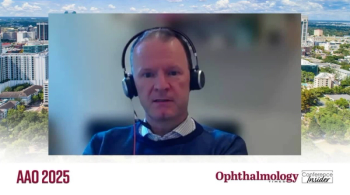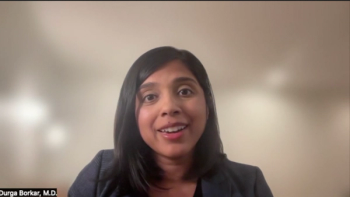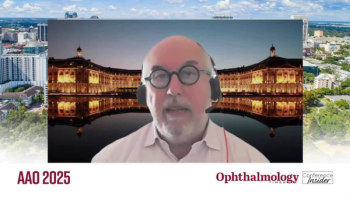
- Ophthalmology Times: July 15, 2020
- Volume 45
- Issue 12
Show me the patients: Patient satisfaction, not surgical landmarks or chart indices, mark of success
Special to Ophthalmology Times
Jerry Maguire borrowed the gist of my statement with “Show Me the Money.”
Nearly 30 years ago, my statement, “Show me the patient,” was my friendly challenge and encouragement for fellow eye surgeons to understand and recognize that the ultimate end point of any eye surgery is patient satisfaction, not surgical acrobatics or chart indices.
This statement is even truer today as social media has become the communication platform for performance review and displays of satisfaction, thus transparently leveling the playing field for both surgeons and patients worldwide.
Related:
As an impatient teacher, more than 25 years ago, I took it upon myself to share each surgical patient of mine on camera (non-incentivized and unsupervised). These patients are among some of the most demanding in the world’s most litigious country.
As a result, walking my talk and perhaps initiating what I am told was one of the most dangerous and uncontrolled ways to be held accountable for my work - for life.
Today’s fully informed patients have high expectations regarding their postoperative results and are not willing to become obscure points on scatter grams and graphs representing failed surgeries meekly hidden by podium surgeons in statistical averages. They will be heard and seen.
They arrive in most cases to their eye doctors fully informed on all three levels: their condition, the surgeon under consideration, and technologic options that in many cases could even take the doctors by surprise.
The availability of this information results in not only highly informed and demanding patients but someone who is already literate about the options they want or that they assume will be presented to them by surgeons who will be held accountable if those options are either not offered, or if the surgeon cannot perform these trend-seeking procedures.
Related:
Flaunting the technology
Repeated examples of this are evident at every conference and in publication, in which well-meaning surgeons talk about technology, surgical maneuvers, and improved chart indices such as topographic “corrections,” while patients may be distraught with their poor vision and unable to understand why their surgeon does not understand that having a “clear transplant” or “better topography” is not what they came for. They wanted to SEE. To them, their award-winning surgeon completely failed.
We certainly need innovation and to many this is the elixir of our privileged profession, but instead of dwelling on “new” technology hard sells, and “new” surgical steps, surgeons need to concentrate on the patient’s endpoint.
A surgeon could sensationally fixate a lens implant, laboriously replace a cornea, or place fancy sutures, but if the resulting vision is poor, the acumen or bravado with which the surgery was performed does not matter much.
We cannot and should never guarantee outcomes. Of course, we are human and can make mistakes, but driving along a path of surgical acrobatics and technology newness, while arriving at the wrong destination (improper vision goal) is even less forgivable today than ever before.
Every patient who presents to an ophthalmologist comes with two requests, that is, to see and to do so without glasses. For these patients, those are the only gauges of success, accompanied by the absence of pain, rapid recovery, and competitive pricing.
Related:
Every ophthalmologist should keep in mind that vision is the highest measure of success and fortunately or unfortunately the easiest sense to measure in any language with a universal eye chart.
No patient knows what a “perfect” outcome after knee surgery is or how high your shoulders should go after shoulder surgery, but a universal eye chart with the common base knowledge of “20/20 perfect vision” allows any patient to be examined anywhere in the world and their surgeon’s failure to be displayed mercilessly.
A refractive or cataract surgeon (since these surgeries are done while the patient is awake) who wishes to share and show their surgical maneuvers also should be able to demonstrate their patient’s reactions in those surgical videos, including intraoperatively, immediately after surgery, and on day 1 postoperatively, with that patient exclaiming happily that they have no pain, are enjoying their experience, and are thrilled with their vision.
Hiding patient reactions while displaying surgical acrobatics on how needles were passed, implants handled, or tissues manipulated in the eye can no longer suffice as a mark of accountability. Show me the patient.
Related:
Cooking up success
I like to teach eye surgery as a custom-tailored art and use analogies similar to the art of cooking, i.e., just completing the task of cooking a meal without burning the food is not considered a success.
A real chef should be able to not only cook flawlessly, but also visualize the goal of that endeavor, that is, to deliver a nicely arranged, tasteful, aromatic and uniquely balanced, individually designed meal. If the cook is so immersed in showing off his or her cooking methodologies, but ultimately no one wants to eat the food, the effort is effectively a failure.
I insist that all eye surgeons, should already know the full spectrum of kerato-lenticulo-refractive surgeries and technologies, but they also should become “master chefs” using all the techniques, all the “equipment in the kitchen,” and all the ingredients to individualize the “vision recipe” for each patient.
The goal is to not only eat what has been prepared but also enjoy the tasteful, aromatic, well-presented dish completely designed for the individual’s dietary requirements. That truly then is “custom vision” delivered to that patient’s best potential.
Related:
The flaw of advertising eye surgery as “robotic’ with the hard sell on “new-generation lenses” has landed many surgeons in a “soup.”
In my practice, that is mostly referral and comprised of patients with complications and those who are seeking a second opinion, I see firsthand the outcomes of these “innovative,” unnecessarily extensive, and logically convoluted surgeries.
However, the notes of these well-meaning referring surgeons reflect their own perceptive success in documenting a “clear transplant,” “well-placed lens implant,” “improved topography,” and other such objective indicators, while nearly disregarding the fact that the patient is painstakingly seeking a second opinion due to disappointment with the visual result.
The dissatisfied patient has no interest in knowing about the ocular maneuvers, the numbers of needles or sutures, or the new technologies applied, because the end point in his or her eyes is a failure.
The result is that the patients will report their visual failure and spread it on social media to ensure that their negative experience is spread far and wide while repeatedly cajoling surgeons to understand that the patient and the end point and not the surgical maneuvers or technologies are the goals.
Related:
Three trends
Premium cataract surgery still leads this pack among patients seeking second opinions in my practice. In my opinion, most of these referred cases are the direct result of an inadequate understanding of which lens implant technology works in which situation.
The good news is that most of these cases can be improved to “20/20 happy” using kerato-lenticulo-refractive techniques to correct residual refractive errors or adjust the improperly coordinated optics between the cornea and the premium lens implant.
The next trend that is currently on the rise among unhappy patients are the use of indiscriminate cross-linking in keratoconus patients leaving them visually disabled and dependent on contact lenses.
Surgeons may continue to present data at conferences about their success in “arresting” keratoconus topographically while patients in many cases are left with poor vision.
Related:
The third trend involves patients with dry eye who may have undergone numerous treatments with medical notes reflecting the improved status of the ocular surface while they continue to be symptomatic and seek help.
These patients present for a second opinion and they are angry, feeling misled by the dry eye specialist, who to them seem obviously incentivized, and having paid exorbitant amounts of money for numerous diagnostic tests and “new” technologies only to have left dissatisfied.
Once again, the doctors record improvement in tear film osmolality, photographic progress, and other indices, while patients may have little improvement in their suffering.
Related:
An important category of patient who may cajole their surgeons into surgical manipulations are those with multiple complexities that have unnerved the surgeon enough that they are consumed to anatomically repair the eye as opposed to focusing on the vision.
Common examples of these are LASIK flap issues, subluxed cataracts, post-traumatic distorted pupils, previous radial keratotomy surgery, and corneal scarring. Instead of thinking about scleral support lenses, iris repair, or corneal transplants, all of which may surely be needed, I encourage surgeons to think of vision first and surgery second. Surgeons should consider all anatomic deficiencies and determine if they can be corrected optically using the least interventional and elegant techniques.
Designing the treatment
Having performed thousands of cases over three decades that stand testimony to this vision-centric approach, which despite my personal drive for surgical artistry of a perfect looking eye, confirms this approach to vision and patient satisfaction to be a worthy goal. In fact, it may be the only endpoint worth talking about.
Numerous patients referred to me with LASIK complications, corneal ectasia, corneal scars, irregular astigmatism, improper topographies, unhappy premium IOL cases, subluxed lens implants and distorted pupils may still have those anatomic abnormalities, but I aim for refractive neutralization to 20/happy patients.
For example, I have hundreds of cases in which the corneal scar can still be seen on slit lamp but the patient is thrilled with their 20/20 unaided vision.
“Show me the patients” applies not only to today’s holy grail of eye surgical success for a patient but also to those of us teaching surgery. I encourage colleagues to not just show videos demonstrating their intraoperative procedures or indices that they think they miraculously corrected.
I tell them to “show me the patient” intraoperatively, immediately postoperatively, day 1 postoperatively, and one year postoperatively. That patient should be happy, comfortable, and satisfied and want to spread your good name on social media.
Related:
In my practice, I grant my patients full liberty to post on social media, which holds my feet to the fire as it is neither controlled by me nor incentivized; additionally, it is a hallmark of my integrity in transparently sharing with colleagues. Nothing is hidden in statistics; these are real people who can be reached by anyone at any time.
Additionally, if any patient did write something negative, as long as I can investigate my work and find that I was right and did care and delivered everything I promised, I do not ask that patient to remove their comments.
It may surprise you and unbeknownst to me, many of my patients even keep logs on the progress of their eye surgery on social media and document periodically while interacting with potential patients worldwide. So we surgeons are being held accountable throughout our lives.
In summary, I believe the current measure of surgical success is “A fully paid, non-incentivized, high-Q patient wishing for a selfie with you postoperatively and wanting to post that on their timeline.”
So, show me the patients!
Arun C. Gulani, MD
E: [email protected]
Dr. Gulani, an anterior segment specialist and creator of the Corneoplastique concept of vision correction, is the founder of Gulani Vision Institute in Jacksonville, FL.
Articles in this issue
about 5 years ago
Aspheric, aberration-free IOL leverages technology for performanceabout 5 years ago
Emerging opportunities — and risks — with telehealth in a pandemicabout 5 years ago
Toric stability: A minor change with a major impact for patientsabout 5 years ago
Diagnosing a 'down looker'about 5 years ago
Dropless, hands-free regimen key for patientsabout 5 years ago
Amid pandemic, friendly bugs can help protect the eye from infectionabout 5 years ago
Gene therapy offers hope for choroideremiaabout 5 years ago
Machine-learning algorithms could help predict course of NPDRabout 5 years ago
Thyroid eye disease: Not limited to visual impairmentNewsletter
Don’t miss out—get Ophthalmology Times updates on the latest clinical advancements and expert interviews, straight to your inbox.






















































.png)


